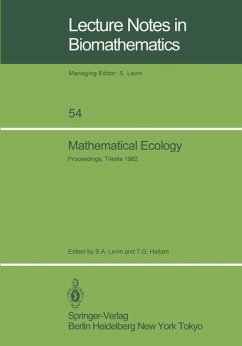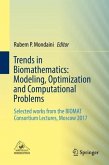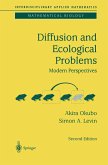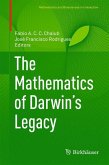Mathematical Ecology
Proceedings of the Autumn Course (Research Seminars), held at the International Centre for Theoretical Physics, Miramare-Trieste, Italy, 29 November ¿ 10 December 1982
Herausgegeben:Levin, S. A.; Hallam, T. G.
Mathematical Ecology
Proceedings of the Autumn Course (Research Seminars), held at the International Centre for Theoretical Physics, Miramare-Trieste, Italy, 29 November ¿ 10 December 1982
Herausgegeben:Levin, S. A.; Hallam, T. G.
- Broschiertes Buch
Andere Kunden interessierten sich auch für
![Trends in Biomathematics: Modeling, Optimization and Computational Problems Trends in Biomathematics: Modeling, Optimization and Computational Problems]() Trends in Biomathematics: Modeling, Optimization and Computational Problems75,99 €
Trends in Biomathematics: Modeling, Optimization and Computational Problems75,99 €![Diffusion and Ecological Problems: Modern Perspectives Diffusion and Ecological Problems: Modern Perspectives]() Akira OkuboDiffusion and Ecological Problems: Modern Perspectives45,99 €
Akira OkuboDiffusion and Ecological Problems: Modern Perspectives45,99 €![Hyperbolic and Kinetic Models for Self-organised Biological Aggregations Hyperbolic and Kinetic Models for Self-organised Biological Aggregations]() Raluca EftimieHyperbolic and Kinetic Models for Self-organised Biological Aggregations39,99 €
Raluca EftimieHyperbolic and Kinetic Models for Self-organised Biological Aggregations39,99 €![Dispersal, Individual Movement and Spatial Ecology Dispersal, Individual Movement and Spatial Ecology]() Dispersal, Individual Movement and Spatial Ecology38,99 €
Dispersal, Individual Movement and Spatial Ecology38,99 €![Mathematics for Ecology and Environmental Sciences Mathematics for Ecology and Environmental Sciences]() Mathematics for Ecology and Environmental Sciences75,99 €
Mathematics for Ecology and Environmental Sciences75,99 €![Mathematical Ecology Mathematical Ecology]() Mathematical Ecology41,99 €
Mathematical Ecology41,99 €![The Mathematics of Darwin¿s Legacy The Mathematics of Darwin¿s Legacy]() The Mathematics of Darwin¿s Legacy81,99 €
The Mathematics of Darwin¿s Legacy81,99 €-
-
-
Produktdetails
- Lecture Notes in Biomathematics 54
- Verlag: Springer / Springer Berlin Heidelberg / Springer, Berlin
- Artikelnr. des Verlages: 978-3-540-12919-6
- 1984
- Seitenzahl: 532
- Erscheinungstermin: 1. Mai 1984
- Englisch
- Abmessung: 244mm x 170mm x 29mm
- Gewicht: 906g
- ISBN-13: 9783540129196
- ISBN-10: 3540129197
- Artikelnr.: 24619633
Hinweis: Dieser Artikel kann nur an eine deutsche Lieferadresse ausgeliefert werden.
- Herstellerkennzeichnung Die Herstellerinformationen sind derzeit nicht verfügbar.
I Autecology.- On the phenotypic plasticity of leaf photosynthetic capacity.- A model of optimal thermoregulation during gestation.- Holling's 'hungry mantid' model for the invertebrate functional response considered as a Markov process. Part 0: A survey of the main ideas and results.- The effect of competition on the flowering time of annual plants.- Evolutionarily stable strategies for larval dragonflies.- II Population Biology.- The storage effect in stochastic population models.- The stable size distribution: an example in structured population dynamics.- "Stage-structure" models of uniform larval competition.- Simple models for age dependent predation.- A model of naticid gastropod predator-prey co-evolution.- A theoretical model for the coevolution of a host and its parasite.- III Community and Ecosystem Theory.- Particle size spectra in ecology.- Species-abundance relation and diversity.- A competition model with age structure.- Stability vs. complexity in model competition communities.- Persistence in food webs.- The structure of cycling in the Ythan Estuary.- IV Applications: Fisheries.- Constant yield harvesting of population systems.- Estimating the response of populations to exploitation from catch and effort data.- Bioeconomics and the management of tuna stocks in the eastern tropical Atlantic.- The multispecies fisheries problem: A case study of Georges Bank.- The legacy of Beverton and Holt.- V Applications: Epidemiology.- Eradication strategies for virus infections.- Models for a class of man-environment epidemic diseases.- Mathematical models of vertical transmission of infection.- Integral equations for infections with discrete parasites: Hosts with Lotka birth law.- VI The Dynamics of Movement: Diffusion Models.- Predator-prey dynamics inspatially structured populations: manipulating dispersal in a coccinellid-aphid interaction.- Oceanic turbulent diffusion of abiotic and biotic species.- Taxes in cellular ecology.- Nonlinear diffusion problems in age-structured population dynamics.- A mathematical model of population dynamics involving diffusion and resources.- VII Spatial Pattern and Diffusion Models.- Critical patch size for plankton and patchiness.- Spatial distribution of rapidly dispersing animals in heterogeneous environments.- Spatial distribution of competing species.- Space structures of some migrating populations.
I Autecology.- On the phenotypic plasticity of leaf photosynthetic capacity.- A model of optimal thermoregulation during gestation.- Holling's 'hungry mantid' model for the invertebrate functional response considered as a Markov process. Part 0: A survey of the main ideas and results.- The effect of competition on the flowering time of annual plants.- Evolutionarily stable strategies for larval dragonflies.- II Population Biology.- The storage effect in stochastic population models.- The stable size distribution: an example in structured population dynamics.- "Stage-structure" models of uniform larval competition.- Simple models for age dependent predation.- A model of naticid gastropod predator-prey co-evolution.- A theoretical model for the coevolution of a host and its parasite.- III Community and Ecosystem Theory.- Particle size spectra in ecology.- Species-abundance relation and diversity.- A competition model with age structure.- Stability vs. complexity in model competition communities.- Persistence in food webs.- The structure of cycling in the Ythan Estuary.- IV Applications: Fisheries.- Constant yield harvesting of population systems.- Estimating the response of populations to exploitation from catch and effort data.- Bioeconomics and the management of tuna stocks in the eastern tropical Atlantic.- The multispecies fisheries problem: A case study of Georges Bank.- The legacy of Beverton and Holt.- V Applications: Epidemiology.- Eradication strategies for virus infections.- Models for a class of man-environment epidemic diseases.- Mathematical models of vertical transmission of infection.- Integral equations for infections with discrete parasites: Hosts with Lotka birth law.- VI The Dynamics of Movement: Diffusion Models.- Predator-prey dynamics inspatially structured populations: manipulating dispersal in a coccinellid-aphid interaction.- Oceanic turbulent diffusion of abiotic and biotic species.- Taxes in cellular ecology.- Nonlinear diffusion problems in age-structured population dynamics.- A mathematical model of population dynamics involving diffusion and resources.- VII Spatial Pattern and Diffusion Models.- Critical patch size for plankton and patchiness.- Spatial distribution of rapidly dispersing animals in heterogeneous environments.- Spatial distribution of competing species.- Space structures of some migrating populations.








